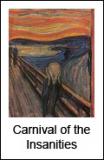 Of the four bombings that Al Qaeda in Iraq conducted last Wednesday, one was limited by the actions of Iraqi policeman at a checkpoint. The policemen, at least five of whom paid with their lives, did not allow an Al Qaeda in Iraq suicide bomber to enter Sadr City. As to the other three bombs, I speculated in my post last Wednesday (linked above) that:
Of the four bombings that Al Qaeda in Iraq conducted last Wednesday, one was limited by the actions of Iraqi policeman at a checkpoint. The policemen, at least five of whom paid with their lives, did not allow an Al Qaeda in Iraq suicide bomber to enter Sadr City. As to the other three bombs, I speculated in my post last Wednesday (linked above) that:
a. the largest of these bombs, the one targeted at Sadriyah Market, had either been detonated inside the concrete defenses that should have been emplaced as a part of Operation Safe Market or that the bomb was possibly so large as to have rendered the defenses unworkable; and
b. the other two bombs, both of which resulted in very few casualties, may well have been as a result of the defenses put in place as part of the surge.
Today, there is confirmation on both issues from a Washington Post story:"That's part of the concrete caterpillar," Petraeus said, pointing out a barrier going up in a neighborhood in west Baghdad. "That market was shut completely down when I took command -- now it has 200 shops," he said.
Those are the four car bombs that Give 'Em Surrender Harry used as justification to prove that the surge has failed. Actually, only one of the bombs succeeded in its reaching its target - the Sadriyah Market. Now we know Al Qaeda in Iraq was able to explode a bomb there because of negligence. It is incumbent upon the Iraqi police, as well as the U.S. and Iraqi forces in Baghdad, to police the barricades around the reopened markets, and it is incumbent upon the Iraqi people to scream at the top of their lungs if they see a breech in the barricades. The former is a matter of going back and identifying the party with responsiblity for policing that particular barricade. The latter is a matter of educating the public to take a bigger role in their own defense. Neither is an indicator that the surge has failed or that the strategy of the plan is flawed. Rather, they are indicators of a failure during the surge that needs to be addressed.
The walls helped divert the multiple car bombs in Baghdad on Wednesday that killed more than 170 people. Three exploded short of their targets, but the fourth and deadliest vehicle bomber was able to enter a market because someone had removed part of the barrier to gain easier access, U.S. officials said.
Sunday, April 22, 2007
And Now We Know
Posted by
scott
at
10:57 AM
![]()
Labels: al qaeda in iraq, Baghdad, Iraq, Petraeus, Sariyah Market, surge, war
Subscribe to:
Post Comments (Atom)



No comments:
Post a Comment